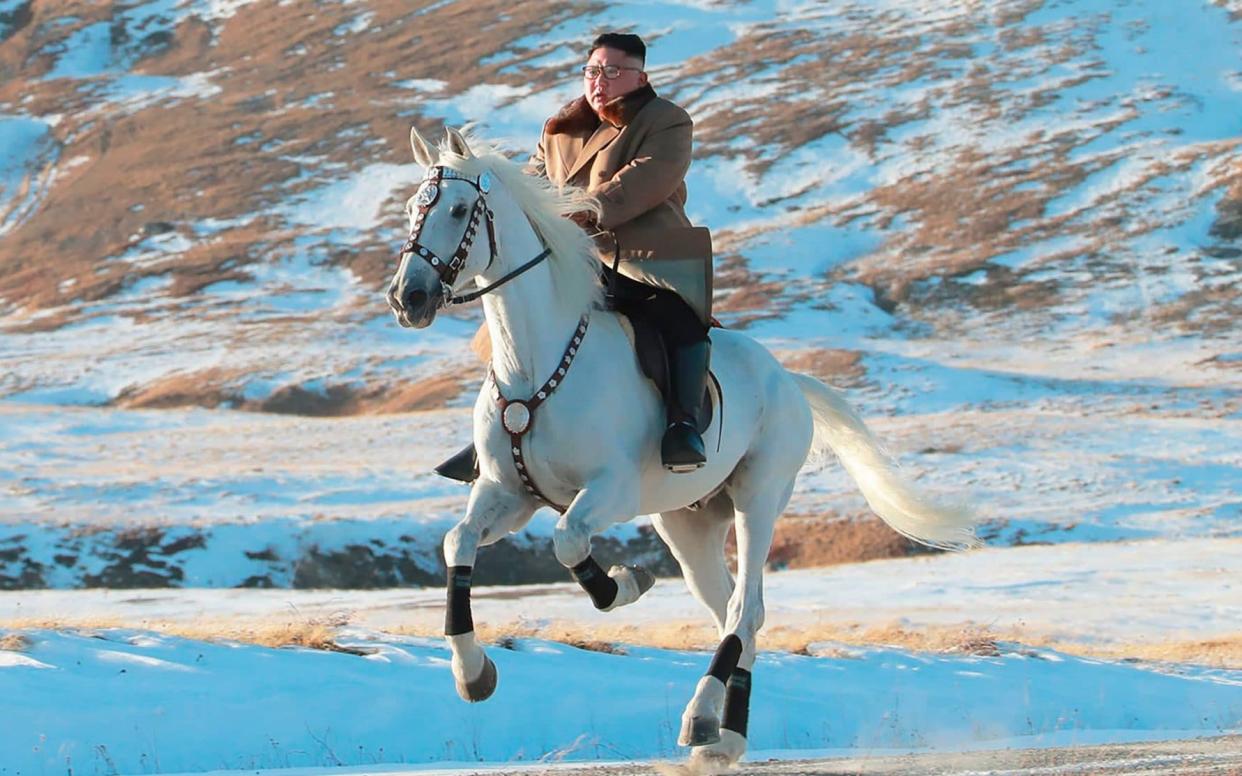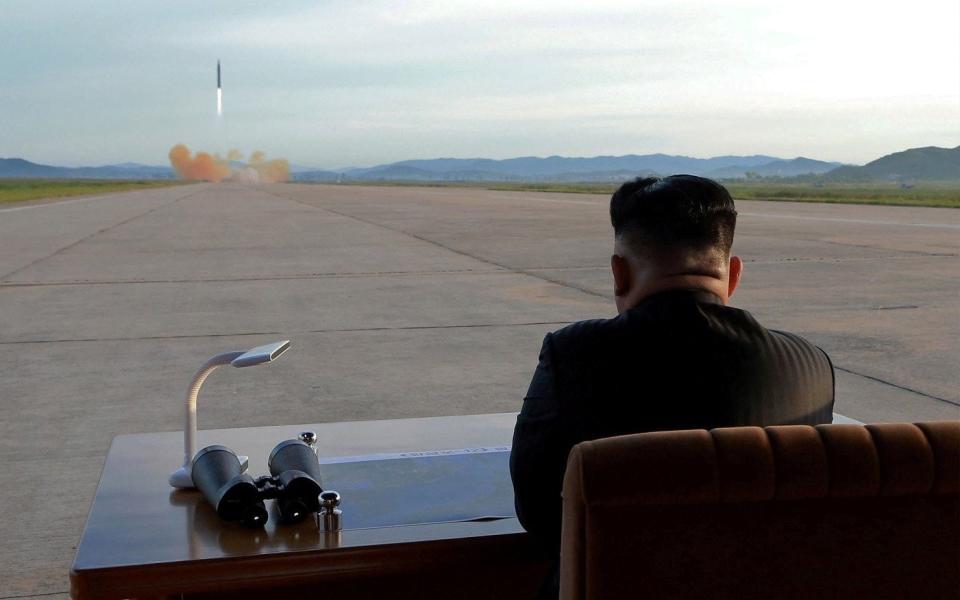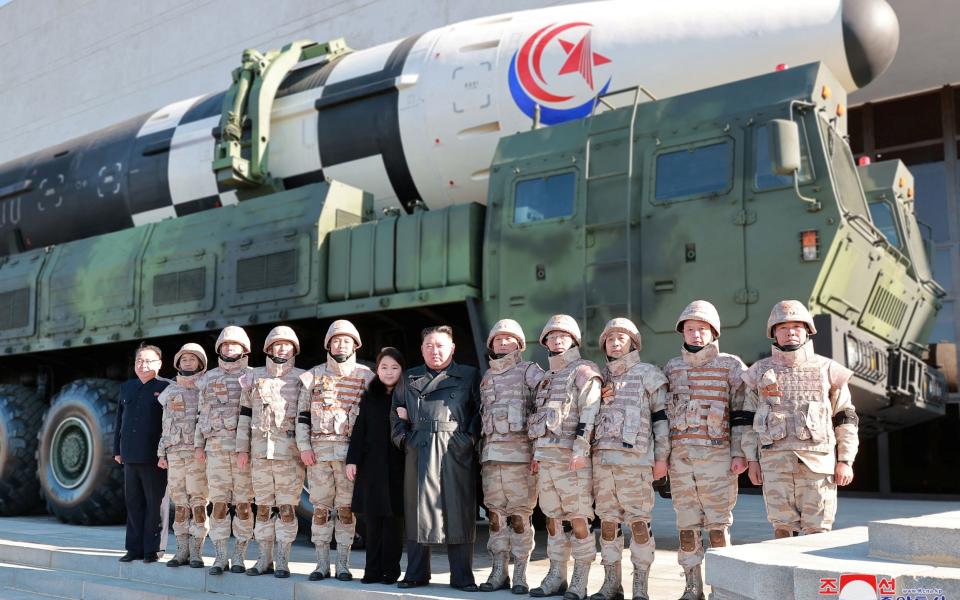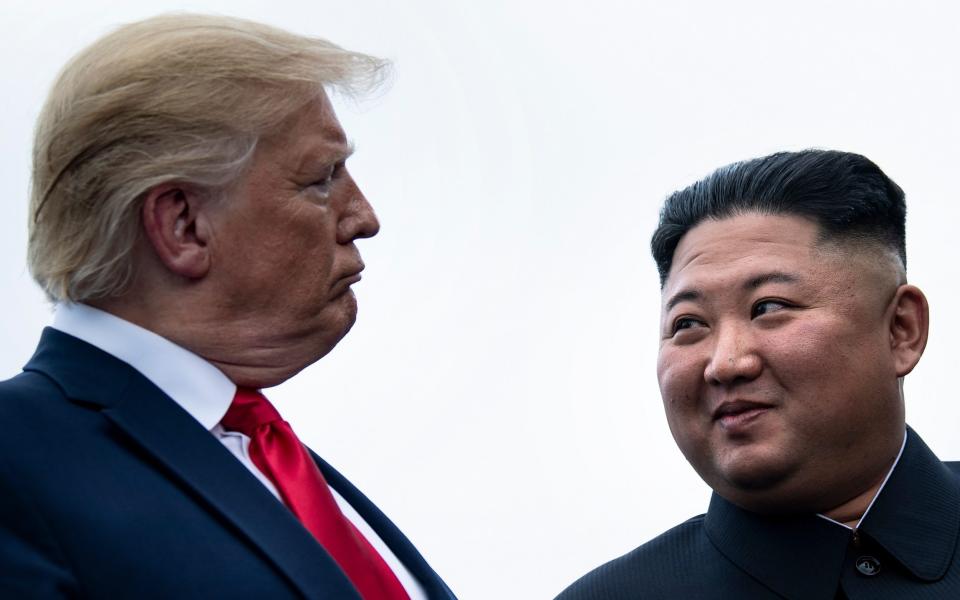Kim Jong-un’s midlife crisis: ‘He’s crying after drinking a lot’

- Oops!Something went wrong.Please try again later.
A distinct puncture hole on a fleshy right forearm, seen just inside the sleeve of a boxy Mao suit. This tiny mark, when first spotted on Kim Jong-un in May 2020, caused an instant reaction among observers of the North Korean regime. Was it the trace of an IV drip? A giveaway of surgery? At the very least, it was an unusual sign of vulnerability in a man who rules his nation with a suffocating grasp.
The needle mark was seen on footage shortly after Kim had been out of public view the previous month. Rumours had circulated that he was either dead or in a vegetative state. When he was finally seen, touring a fertiliser factory, foreign medical observers concluded the wound could be related to a cardiovascular procedure, possibly for a stent placement.
The truth never emerged. So furtive is Kim about his health that on rare trips abroad he travels with his own toilets, to prevent foreign intelligence services scouring his excretions for clues. But the dramatic weight loss that followed his 2020 health scare, possibly due to bariatric surgery, is proof that even dictators must endure the trials of middle age.
This month, according to our best guesses, Kim turns 40. It’s indicative of how little the outside world knows about him that conflicting sources will put him at 39 or even 38. Either way, the approach of his fifth decade brings new anxieties.

‘He probably feels more mortal now than he did three years ago, and he had Covid earlier this year apparently as well,’ says Peter Ward, a North Korea expert and post-doctoral researcher at Seoul’s Kookmin University.
The regime itself appears to have acknowledged Kim’s mortality, quietly creating the unprecedented role of ‘first secretary’ – a de facto deputy – in the ruling party hierarchy. ‘It seems to be because they are concerned about managing another illness,’ says Ward.
Since 2011, Kim has secured his power base, brutally putting down any threat to his rule. But the impact of a global financial crisis and sanctions on the North Korean economy – along with climate change wreaking havoc on farming – could present the leader with his toughest decade yet, thinks Ward.
Adding to the pressure on Kim will be the battle to block the influx and spread of information that could destabilise his strictly curated persona. To North Koreans, Kim is sold as a benevolent provider and semi-divine figure who inspires devotion and fear.
To the rest of the world, he is almost a figure of ridicule. Last March, when he appeared in a Top Gun-style propaganda movie, clad in a shiny leather jacket and aviator shades while walking past a monster missile – all in dramatic slow motion – he was mocked by the West.
Yet the threat he poses globally is no joke. One muggy Pyongyang morning in August 2017, Lindsey Miller was woken at 6am by a deep rumbling. Her body shook as she ran out to the garden to look into the sky. ‘It sounded like an aeroplane going overhead but it didn’t fade away,’ she recalls now.
The author of North Korea: Like Nowhere Else, Miller lived in Pyongyang from 2017 to 2019 with her diplomat husband. She is one of the few Westerners to have experienced the roar of a North Korean ballistic missile test as a Hwasong-12 took off from the capital’s airport.
City residents carried on normally, Miller recalls. ‘The thing that made me more nervous was the response internationally. I was scared,’ she says. ‘It felt like a very real sense of danger.’ Diplomats were told to pack a bag in case of an emergency exit. ‘There were North Koreans who said how stressed they felt. They were worried about the potential for real war breaking out,’ she adds.
Kim seems set on raising the stakes. Since January 2022, he has test-launched an unprecedented volley of ballistic and cruise missiles, including a purported hypersonic weapon and his largest missile, the Hwasong-17, designed to carry a nuclear warhead more than 9,300 miles, within reach of the US mainland.

There had been a respite from aggression in 2018, during talks between Kim and then-US President Donald Trump. But the cycle of intense military escalation has since resumed; intelligence officials now warn Kim is gearing up for a seventh nuclear test, possibly a tactical weapon, and further confrontation with Seoul, Washington and the West.
So, what could Kim Jong-un be capable of?
In Asia, the significance of turning 40 is an expectation that a person ‘does not waver in their judgements’, explains Chun In-bum, a former lieutenant general in the South Korean army. ‘Kim Jong-un’s legacy is a Maoist, Stalinist legacy,’ says Chun. ‘So if he is 40, he is probably going to think that, “My path is the right path”… He is going to be more convinced of who he is and he will be very hard line.’
A tendency towards ruthless determination was already evident in Kim as a child. ‘He had such an abnormal childhood and was raised in such a dysfunctional family, there is really no other way that he could have turned out,’ says North Korea expert Anna Fifield. ‘From a very early age he was treated like a princeling in a way that not even the British Royal family would be.’
Fifield’s 2019 biography, The Great Successor, pieces together his life story. As a child Kim knew he would be handed the keys to the kingdom, after his dictator father Kim Jong-il identified him as more suitable for iron-fisted rule than his older brothers.
The stunning vistas along the eastern coastal resort of Wonsan provided the backdrop for Kim’s early years, which he spent sequestered in opulent villas with high iron gates. The vast property still plays a special role in his playboy lifestyle.
Kim’s decadence may be concealed from his hungry subjects, but high-resolution satellite imagery allows the world to view his expanding property empire. Recent pictures of the Wonsan enclave have revealed four cruise ships and a marina, with 10 villas dotting a 530m-long white sandy beach and manicured gardens. One boat is 80m in length and is said to boast dual twisting water slides.
He married Ri Sol-ju in 2008, and is thought to have three children. The Kim family enjoys as many as 30 luxury villas, and several private islands, according to Bruce Songhak Chung of South Korea’s Kyungpook National University. And in September, new verified images showed the expansion of ornate buildings at Kim’s lakeside mansion in South Pyongan province.

But now Kim faces the challenge to all midlifers: how to mitigate the threat he poses to himself. Overweight, a heavy smoker (of local brand 7.27 cigarettes) and drinker (he prefers fine spirits and expensive French wines), he frequently ignores the advice of his doctors and wife to exercise and cut back on indulgences. His father died at the age of 69. Kim’s long absences from the public eye suggest he is dealing with an array of serious health problems.
‘I heard he is crying after drinking a lot. He is very lonely and under pressure,’ says Dr Choi Jinwook, a Seoul-based North Korea academic.
In November, Kim unexpectedly pushed his ‘beloved daughter’ Kim Ju-ae into the spotlight. In her first introduction to the world, Kim was seen gently holding her hand in choreographed photographs as they inspected a new intercontinental ballistic missile. Analysts were left guessing about his message. Was the girl in the white puffy jacket and red shoes his heir? Or simply a prop to humanise him? Ju-ae, who was born in 2012, would be too young to take over in the event of his sudden death.
There is wide consensus among observers that the role would temporarily fall to his ambitious younger sister, Kim Yo-jong, who has often been spotted at his side, carrying his files or even his ashtray. ‘Family interests come first,’ says Andrei Lankov, a professor at Kookmin University in Seoul, and an authority on North Korea.
There are no reliable estimates of Kim’s personal fortune – in 2013, South Korean media suggested it could be $5 billion – but his personal assets grow even as dangerous levels of hunger rise in the nation of 26 million.
Last year, he warned citizens to brace for a crisis similar to the 1990s famine, which is believed to have killed up to 3.5 million people. In an interview with me last year, Professor Hazel Smith of the Centre for Korea Studies at London’s School of Oriental and African Studies confirmed that food insecurity is now at a similar level. ‘The conditions that we had in the famine years that precipitated malnutrition are in place today,’ she said. ‘There is starvation in North Korea right now.’

The crisis has been building for years thanks to the Kim family’s mismanagement of the agriculture sector and a centralised system that focuses heavily on providing food for the military and political elites, at the cost of the general population.
In 2019 and 2020, a string of typhoons hammered harvests and sent the cost of maize and rice soaring. ‘There is obviously climate change and long run environmental impacts,’ says Ward. ‘The point is their inability to handle them and the fragility of their supply system is not an environmental issue per se.’
Shortages grew in 2021 even as the pandemic forced the UN’s World Food Programme to suspend operations in the country. It warned that another poor harvest meant the North Korean population, already 40 per cent undernourished, would be short of about 860,000 tonnes of food that year.
Add in the impact of global sanctions and plunging trade with China due to border closures, and by June 2022, the South’s government-backed Korea Development Institute was warning the isolated North could fall into a ‘famine in silence’.
Naturally, Kim has never gone hungry. He was shielded from the 1990s famine as a child in his Wonsan paradise, with huge playrooms filled with toys and kitchens full of pastries and tropical fruits. Yet Fifield’s biography quotes Kenji Fujimoto, a Japanese sushi chef who spent years serving the Kims, as saying that a precocious Kim endured a solitary childhood, cut off without playmates.
Aged 12, he turned up with a ‘pudding-bowl haircut’ under the alias Pak-un at a $20,000-a-year international school in Bern, Switzerland. His maternal aunt and uncle Ko Yong Suk and Ri Gang cared for him and his older brother Jong-chol, later defecting to run a dry-cleaning business outside New York. ‘We lived in a normal house and acted like a normal family,’ Ko told Fifield. ‘I made snacks for the kids. They ate cake and played with Legos.’
Kim, though, was short-tempered, stubborn and intolerant. Classmates from the school recalled a loner who displayed frustration at his academic weaknesses. ‘He kicked us in the shins and even spat at us,’ recounts one in the biography. Others remembered his aggressiveness and trash talk on the basketball court. But his Portuguese friend João Micaelo described him as quiet, decisive and ambitious.
In 1998, Kim’s privileged European bubble imploded after his mother was diagnosed with advanced breast cancer; he returned home to face his destiny, taking on his father’s mantle after his death. His youth and Western education raised hopes that he might be more inclined towards reform, but those expectations quickly fizzled.
‘He realised if he was just treated normally, he wouldn’t be anyone,’ says Fifield. ‘He needed to keep this system completely intact, or his family would lose all of its power and status.’
Kim Jong-un’s 11 years in power have been defined by inhumanity and a determination to establish his reclusive regime as a nuclear state. The glimpse of Kim at the 2018 Singapore Summit, greeting Donald Trump with a wide smile, was all part of an act, says Fifield. ‘The real Kim Jong-un is the one that lives in Pyongyang and is Machiavellian,’ she says. ‘He is trying to strike fear into the heart of the populace and the top officials of the regime, to make sure that they don’t think about crossing him but also to generate the other half of the Machiavellian equation – which is love.
‘He completely played Donald Trump like a fiddle… all of it was designed to bolster his legitimacy at home and give him that brag book of photos where he could show people of North Korea that he is respected and treated as an equal by all these other leaders.’

His wife Ri Sol-ju – described by Fifield as the ‘Kate Middleton’ of North Korea in the sense that she is an aspirational yet approachable figure – is said to have tried to modernise the dynasty. She was even seen holding hands with the South Korean First Lady at a summit in 2018. But Kim operates with a chilling cruelty.
Nine years ago he reportedly ordered the execution of his influential uncle and mentor Jang Song-thaek, accusing him of treason. Unconfirmed reports suggest Jang was mown down by anti-aircraft guns, and his body incinerated with flamethrowers. The facts were hazy, but the message was clear. It was reinforced in 2017 by his alleged decision to murder his half-brother Kim Jong-nam at Kuala Lumpur airport using a nerve agent.
Lankov describes Kim as a sometimes capricious, but rational ‘third-generation CEO’; a man prepared to be brutal internally, while also building a nuclear weapons deterrent in order to protect himself and his family from foreign invasion. ‘His goal is very simple – to die a natural death in his palace, decades later. He wants to stay in power. He understands… if he loses power, very soon he will probably lose his life and everyone who he loves,’ Lankov says. ‘He is protecting his life, not lifestyle.’

Having neutralised the North Korean elites, whose prosperity is entwined with his fate, Kim tried to prevent a popular uprising by enforcing ‘information isolation’. Jihyun Park, 54, a defector and human rights activist who now lives in Manchester, tells me that as a child growing up under Kim Jong-il’s reign, she had no concept of how desperate the North Korean situation was. At school they were ‘brainwashed’ and ‘we believed everything we were told’.
Back then, in the pre-internet era, indoctrination was easier. Kim, while established as royal stock, has a more fragile cult of personality than his father and grandfather, Kim Il-sung, the nation’s founder. The younger Kim’s propaganda is less impressive, reduced to outlandish tales of learning to drive aged three, or a purported ability to control the weather. The first known mural depicting Kim’s exploits – digging at a greenhouse complex – has only recently appeared. It pales in comparison to the resplendent statues of his father and grandfather.
Hanna Song, from the Database Center for North Korean Human Rights in Seoul, said Kim’s youthful interest in technology is also a double-edged sword. He has to keep the younger, tech-savvy generation under control, through draconian laws and punishments for ‘anti-socialist behaviour’. In 2021, he unleashed a crackdown on ‘words, acts, hairstyle and attire of young people’ and a fresh ban on unsanctioned videos, broadcasts and speaking in a ‘South Korean’ style. Radio possession risks years in prison, and access to the open internet is blocked, allowing only a heavily censored state intranet.
Song said defectors’ motivations have shifted, from basic survival in the early 2000s to a new disillusionment with the leadership. ‘We’ve heard about North Koreans who are similar ages to Kim Jong-un who just couldn’t believe they had to serve a leader with his little experience,’ she says.
There could be one more astounding plot twist – and it’s a development that will only add to Kim’s mounting anxieties. In 2017, after his father Kim Jong-nam was poisoned in Malaysia, a young man called Kim Han-sol was spirited out of Macau, via Taipei, the capital of Taiwan, to an unknown destination. He is Kim Jong-un’s nephew.
Now 27, is he the other Kim being groomed in the wings for leadership at the earliest opportunity?
‘He seems to be somewhere in Europe being protected and taken care of, which I think is a great thing to do,’ former lieutenant general Chun tells me, ‘because we need him for some eventualities that might occur in North Korea. I am glad somebody is looking that far ahead.’

